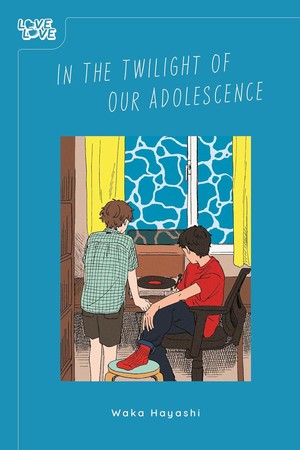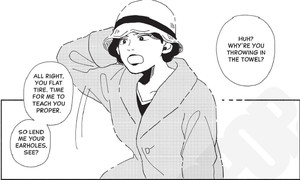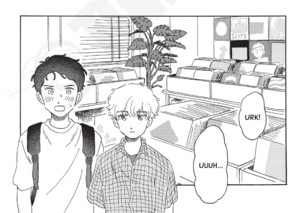The Fall 2025 Manga Guide
In the Twilight of Our Adolescence
What's It About?

A story about boys who grow from boys to adults during adolescence, and who worry, make mistakes, and gradually come to terms with the many facets of life.
Tanahashi Yusei is a popular boy who excels in both academics and sports, and naturally has people gathering around him. Yusei has a classmate he admires, but he can't tell anyone about him. That person is Nakagawa, an inconspicuous boy who his friends don't even seem to notice. The two become closer after a certain incident...
In the Twilight of Our Adolescence has art and story by Waka Hayashi. English translation is done by Christine Dashiell. Lettering by Vibrant Publishing Studio. Published by Tokyopop (November 11, 2025). Rated T.
Is It Worth Reading?
Rebecca Silverman
Rating:

In the Twilight of Our Adolescence feels like a book that wants to be more than it is. That's not to suggest that it's a bad book, or even an unsuccessful one; Waka Hayashi's series of quiet short stories does tap into the uncertain space between being a child and an adult, even in the fourth story, which stars an actual grown-up. But it never quite goes deep enough in its explorations, and that leaves it feeling more like a “should have been” than an actual satisfying read. No one is sadder about this than I am.
The main story follows two boys in their final year of middle school. Tanahashi seems to have it all, while Nakagawa is on the fringes, but in Tanahashi's mind, no one is better than Nakagawa. Although they only shared a class in their first year, Tanahashi has been fixated on him ever since, and he can't quite pinpoint the reason why. When they reconnect, the two instant hit it off, discovering that their shared interests are at least in part shared because they've been observing each other the whole time. There's a lovely sense of inevitability about their burgeoning relationship, and Nakagawa's certainty about who he is and who he likes rubs off on Tanahashi in the best of ways. It sounds wonderful on paper, but there's something scanty in the actual unfolding of the story that kneecaps the piece. Part of it is that they don't act like third year middle schoolers; they read much more like third year high school students. But I think the most significant issue is that the story is simply too short. This would have benefited from being at least an entire volume long, giving the boys space to truly show their growth.
The two shortest stories in the collection do expand upon this a bit. One follows Manami, the girl who had a crush on Tanahashi and has to face that she's been rejected for Nakagawa. This is a small exploration of love on paper versus in reality, and it works well, although again, it would have benefited from being longer. The other piece is nearly perfect, though: just a snapshot of the boys in high school, letting us know that they're doing well and are still together.
By far, though, the strongest story in the book is the final one. This is completely standalone and supernatural – it's about a college student whose crush picks out a vintage coat for her from the shop he works at. When she brings the coat home, it manifests a ghost – a woman from the 1930s who talks like a dizzy dame from a hard-boiled crime novel and aims to help the heroine find her fashion happiness. The story is surprisingly heavy as the truth about who the ghost is comes to light, and thematically it's very similar to the rest of the book, just seen through a different lens. The simple art for all four stories works best here, as well, and on the whole this piece feels like the best showcase of the creator's talents.
I wish I had liked the whole book more, but upon reflection, I have to say that I'm still pretty pleased with what I got.
Lauren Orsini
Rating:

Combine an indie-comics art style with a retro vibe and you get In the Twilight of Our Adolescence, a collection of four mostly-connected stories about teenagers figuring themselves out. Romance takes a backseat to self discovery, but the bonds these characters develop as they work through this universal metamorphosis we call being a teen offer a unique layer of warmth. References to analog radio, vintage records, and thrifted clothes give the story a comfortable and lived-in feeling even in this thoroughly modern, inclusive, and affirming set of tales. The strong emotional beats combined with the simple, scribbly art gives the entire work the impression that it's coming straight from the heart.
The first and longest chapter is a romance between two boys who connect over a shared love of radio and a feeling of isolation from their peers. It's an especially tender story where each boy's journey of self-acceptance takes the driver's seat ahead of romance. There's Yusei, who is surface-level popular with his peers, good at school and sports, and has even caught the eye of a pretty girl—but none of this makes him feel happy or fulfilled. He wishes he could be more like Nakagawa, who appears so self-confident that when the teacher asks for boy volunteers to sing soprano, Nakagawa with his yet-unbroken voice immediately raises his hands, seeming impervious to the judgement of their classmates. When Yusei learns Nakagawa likes a specific radio show, Yusei starts listening to it too, and that becomes the opening for them to hang out more and more, not really questioning their bond until a classmate asks, “Are you guys gay?” Despite that loaded question, there's no homophobia in this story, and everyone gets their happily ever after. The second story is about the girl who crushed on Yusei finding solace in friendship (or maybe more?), the third is an epilogue about the main boys planning their bright future ahead.
But I have a special place in my heart for the collection's final story, about a girl and the vintage coat she bought from a secondhand store—complete with its own 1920s slang-talking ghost. This type of localization is especially difficult to convey naturally, but it works perfectly here. All of the coat's expressions, from “razzle dazzle,” to “the cat's whiskers” seem to be from the same time period. Hina thinks her problem is she needs the coat ghost to help her get her crush to notice her, but what the ghost makes her realize is that self-love needs to come first. Yes, even the coat gets a poignant wartime backstory. I had expected this book's first chapter to be the centerpiece of the collection so I was really blown away by the emotional catharsis of this grand finale. From beginning to end, In The Twilight of Our Adolescence is a stand-out comic, from its one-of-a-kind art style, to its raw emotional payoff, to its universal message.
The views and opinions expressed in this article are solely those of the author(s) and do not necessarily represent the views of Anime News Network, its employees, owners, or sponsors.
discuss this in the forum (22 posts) |
this article has been modified since it was originally posted; see change history
back to The Fall 2025 Manga Guide
Seasonal homepage / archives